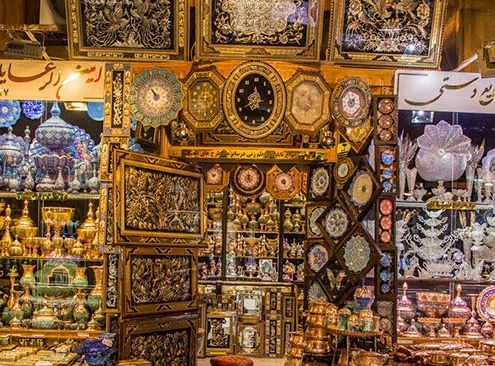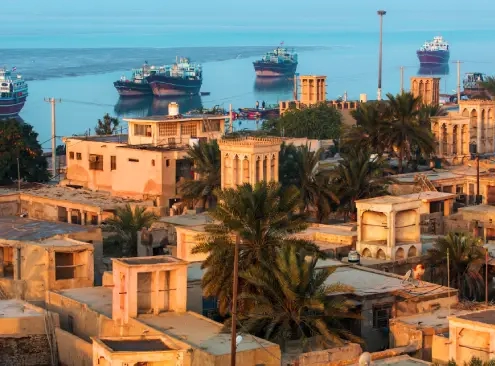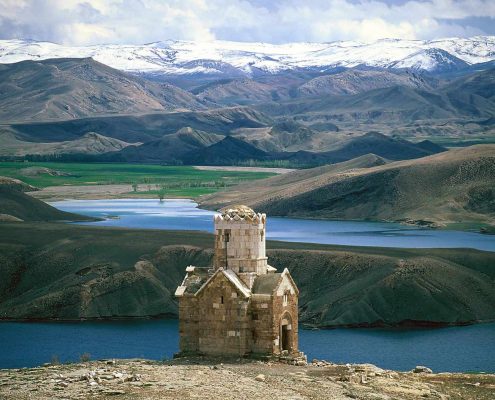
Persian Handicrafts, the Best Souvenirs of Iran
/
0 Comments
Since Iran is one of the oldest civilizations in the world and…

Dowlatabad Garden, the Architectural Jewel of Yazd
Dowlatabad Garden, the architectural jewel of Yazd, is inscribed…

Eram Garden, Shiraz: Photos, History, Opening Hours, Price
Shiraz Eram Garden is among the most beautiful Persian gardens…

Persian Garden, the Paradise on Earth
The Persian garden, in many ways, resembles paradise on Earth.…

Moghadam Museum, a Historic Priceless House in Tehran
Moghadam Museum is a historic priceless house in Tehran and it…

Visiting Iran During Ramadan: Tips & Guide
Ramadan, the ninth month of the lunar calendar (Islamic calendar),…
 https://irandoostan.com/dostcont/uploads/2017/05/Tehran-Museum-of-Contemporary-Art-8.jpg
584
900
Travel to Iran
https://irandoostan.com/dostcont/uploads/2025/05/Irandoostan-logo.webp
Travel to Iran2017-05-15 13:39:502025-04-13 15:17:10Tehran Museum of Contemporary Art: Photos, Architecture
https://irandoostan.com/dostcont/uploads/2017/05/Tehran-Museum-of-Contemporary-Art-8.jpg
584
900
Travel to Iran
https://irandoostan.com/dostcont/uploads/2025/05/Irandoostan-logo.webp
Travel to Iran2017-05-15 13:39:502025-04-13 15:17:10Tehran Museum of Contemporary Art: Photos, Architecture
Bandar Abbas (Beach, Weather, Port, Map)
Bandar Abbas is a port city and it is the capital of Hormozgan…

Qeshm Island, The Paradise of Geologists + Photos
Qeshm Island, located in the serene waters of the Persian Gulf,…

All about Hengam Island (Weather, Dolphins, Ferry, Map)
Hengam Island is located in the south of Qeshm Island and is…

Hormuz Island (Weather, Things to Do, Map)
Hormuz Island, with an area of approximately 42 km2, is a piece…

Hormozgan Province (Things to Do, Weather, Beach, Map)
Situated on the southern coast of Iran, Hormozgan Province is…

Golestan Palace Complex, Tehran: Photos, Video, History
Golestan Palace in Tehran is one of the most spectacular places…
 https://irandoostan.com/dostcont/uploads/2017/03/Espinas-Palace-Hotel.jpg
457
850
Travel to Iran
https://irandoostan.com/dostcont/uploads/2025/05/Irandoostan-logo.webp
Travel to Iran2017-03-12 11:02:092025-04-16 15:22:06Espinas Palace Hotel, Tehran (Book, Review, Photos)
https://irandoostan.com/dostcont/uploads/2017/03/Espinas-Palace-Hotel.jpg
457
850
Travel to Iran
https://irandoostan.com/dostcont/uploads/2025/05/Irandoostan-logo.webp
Travel to Iran2017-03-12 11:02:092025-04-16 15:22:06Espinas Palace Hotel, Tehran (Book, Review, Photos) https://irandoostan.com/dostcont/uploads/2017/02/novotel-tehran-8-e1516537191453.jpg
450
600
Travel to Iran
https://irandoostan.com/dostcont/uploads/2025/05/Irandoostan-logo.webp
Travel to Iran2017-02-25 15:57:522023-09-13 13:17:04Rexan Hotel Tehran (Photos, Review)
https://irandoostan.com/dostcont/uploads/2017/02/novotel-tehran-8-e1516537191453.jpg
450
600
Travel to Iran
https://irandoostan.com/dostcont/uploads/2025/05/Irandoostan-logo.webp
Travel to Iran2017-02-25 15:57:522023-09-13 13:17:04Rexan Hotel Tehran (Photos, Review) https://irandoostan.com/dostcont/uploads/2017/01/iran-doostan.jpg
1764
1764
Travel to Iran
https://irandoostan.com/dostcont/uploads/2025/05/Irandoostan-logo.webp
Travel to Iran2017-01-21 16:29:542020-06-10 21:20:15Iran Doostan Travel Magazine 2015
https://irandoostan.com/dostcont/uploads/2017/01/iran-doostan.jpg
1764
1764
Travel to Iran
https://irandoostan.com/dostcont/uploads/2025/05/Irandoostan-logo.webp
Travel to Iran2017-01-21 16:29:542020-06-10 21:20:15Iran Doostan Travel Magazine 2015 https://irandoostan.com/dostcont/uploads/2017/01/final-magazine-jeld-12120162017low_001.jpg
1847
1800
Travel to Iran
https://irandoostan.com/dostcont/uploads/2025/05/Irandoostan-logo.webp
Travel to Iran2017-01-19 10:19:452020-06-10 21:20:35Iran Doostan Magazine 2017
https://irandoostan.com/dostcont/uploads/2017/01/final-magazine-jeld-12120162017low_001.jpg
1847
1800
Travel to Iran
https://irandoostan.com/dostcont/uploads/2025/05/Irandoostan-logo.webp
Travel to Iran2017-01-19 10:19:452020-06-10 21:20:35Iran Doostan Magazine 2017 https://irandoostan.com/dostcont/uploads/2017/01/traveltoiran-dzordzoriran.jpg
948
1417
Mina Bagheri
https://irandoostan.com/dostcont/uploads/2025/05/Irandoostan-logo.webp
Mina Bagheri2017-01-04 17:06:162025-04-13 15:19:47Iran World Heritage Sites (West & North-West of Iran)
https://irandoostan.com/dostcont/uploads/2017/01/traveltoiran-dzordzoriran.jpg
948
1417
Mina Bagheri
https://irandoostan.com/dostcont/uploads/2025/05/Irandoostan-logo.webp
Mina Bagheri2017-01-04 17:06:162025-04-13 15:19:47Iran World Heritage Sites (West & North-West of Iran)

